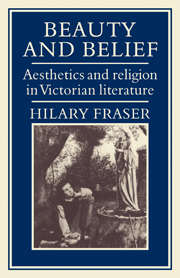Book contents
- Frontmatter
- Contents
- Dedication
- Acknowledgements
- List of abbreviations
- Introduction
- 1 Theology: Keble, Newman, and the Oxford Movement
- 2 Epistemology and perception: Gerard Manley Hopkins
- 3 Criticism: John Ruskin and Matthew Arnold
- 4 Aestheticism: Walter Pater and Oscar Wilde
- Conclusion
- Notes
- Select bibliography
- Index
3 - Criticism: John Ruskin and Matthew Arnold
Published online by Cambridge University Press: 05 November 2011
- Frontmatter
- Contents
- Dedication
- Acknowledgements
- List of abbreviations
- Introduction
- 1 Theology: Keble, Newman, and the Oxford Movement
- 2 Epistemology and perception: Gerard Manley Hopkins
- 3 Criticism: John Ruskin and Matthew Arnold
- 4 Aestheticism: Walter Pater and Oscar Wilde
- Conclusion
- Notes
- Select bibliography
- Index
Summary
The two greatest critics of the high Victorian period, Ruskin and Arnold, unlike the modern critic with his narrowly-defined area of expertise, undertook as their field of intellectual enquiry no less than the whole of human culture. Less immediately concerned with theology than their clerical contemporaries, Keble, Newman, and Hopkins, and more prominently involved in the Victorian world of arts and letters, between them they considered and pronounced upon literature, architecture, painting, religions and societies–ancient and modern, English and European. Both men assume a relationship between religion and aesthetics at every turn, whether they are criticising a painting, a building, or a poem, making recommendations about education, or interpreting the Bible. Yet, in line with their religious positions, they are more concerned with the moral implications of art and aesthetics than with the strictly theological. Ruskin and Arnold also distinguish themselves from the Tractarian tradition by their interest in the moral relationship that exists between art and society. In the course of both of their careers, we see a movement away from an early purely aesthetic criticism of particular works of art towards a more general and socially committed diagnosis of culture in moral and political terms. As Raymond Williams points out:
An essential hypothesis in the development of the idea of culture is that the art of a period is closely and necessarily related to the generally prevalent ‘way of life’, and further that, in consequence, aesthetic, moral, and social judgements are closely interrelated.
- Type
- Chapter
- Information
- Beauty and BeliefAesthetics and Religion in Victorian Literature, pp. 107 - 182Publisher: Cambridge University PressPrint publication year: 1986



